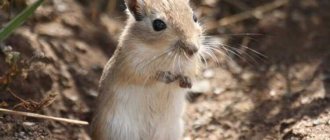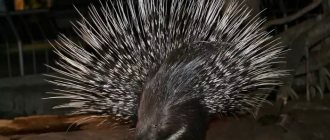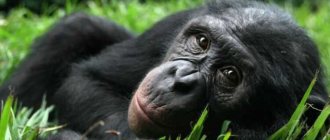Crocodiles are fierce creatures that are full-fledged descendants of dinosaurs that successfully overcame global extinction and evolved. These predatory reptiles have a lot of unique features that make them impressively resilient and adapted to harsh survival conditions.
Lifespan of reptiles in the wild
The order of crocodiles includes 3 families of reptiles:
- real crocodiles;
- alligators;
- gharials.
They all have approximately the same life expectancy.
A baby that has just hatched from an egg has little chance of survival. About 1 in 100 crocodiles live more than a year and reach sexual maturity. Young reptiles are hunted by predatory animals, birds, fish and even larger relatives. When crocodiles reach a weight of several kilograms, there are fewer enemies.
In the wild, the life expectancy of adult crocodiles is on average 50 years, but some individuals can live up to 80 years. Then they gradually lose dexterity, strength, vigilance, and are killed by their relatives. American alligators are hunted by big cats, anacondas and giant otters. People destroy crocodiles for the sake of beautiful, high-quality leather, which is used to make handbags, shoes and other haberdashery products.
Article on the topic: Mastitis forte - instructions for use and reviews
Species of crocodiles
The detachment unites three large families:
- real crocodiles;
- alligators;
- gharials.
Crocodiles are represented by 6 modern genera and 25 species, among which the following are of greatest interest:
- Nile crocodile. Distributed on the African continent. The color is light brown with noticeable dark stripes. It is distinguished by its ferocity and aggressiveness, capable of attacking animals significantly larger than itself.
- Mager (swamp crocodile). The habitat is limited to the territory of India. The color combines dark green and olive colors. It feeds mainly on fish; there are known cases of attacks on people.
- Sharp-snouted crocodile. Lives in fresh water bodies of Central and South America. The skin is colored brown. The diet is based on fish, birds and turtles.
- New Guinea crocodile . Endemic to Indonesia and New Guinea. The skin is gray in color with transverse dark gray stripes. It is exclusively nocturnal and hunts birds, amphibians and crustaceans.
- African dwarf crocodile. The maximum body length of the reptile does not exceed 1.5 m. Protection from larger predators is provided by hard, ossified plates covering the upper part of the body. Due to its habitat in remote regions, very little information has been collected about this species.
- Blunt crocodile. Distributed in the west-central part of the African continent. The body length can reach 2 m. It is nocturnal and rests in burrows most of the day.
- Gharial . Distributed in southern Asia. The main characteristic feature is a very narrow muzzle, adapted for catching fish. Completely safe for people.
How many years do crocodiles live in captivity?
In captivity, crocodiles live more than 100 years. The famous “old-timer”, caught in Australia, was celebrating his 110th birthday at that time. For its fighting character, the reptile was named Cassius Clay in honor of the famous boxer.
Cassius belongs to the saltwater crocodiles; he was caught in the 80s of the last century for repeated attacks on livestock. At the time of capture, the crocodile was, according to experts, about 80 years old, and its teeth were badly damaged. The reptile's current habitat is the zoo on Green Island. Its body weight is about 1 ton and its length is more than 5 meters.
Unusual animal organism
These amazing creatures appeared on Earth more than 250 million years ago. They successfully survived the global extinction that occurred 65 million years ago, when all dinosaurs disappeared from the face of the planet.
The mystery of the “reverse” evolution of crocodiles still remains unsolved. There is an assumption that they were once warm-blooded creatures and lived on land.
Other features of the physiology of crocodiles:
- Reptiles have a 4-chambered heart that functions like a 3-chambered one while underwater. This prevents blood from stagnating in the pulmonary artery.
- When diving underwater, carbon dioxide-rich blood begins to flow in the opposite direction, increasing the normal generation of gastric juice tenfold. This mechanism helps crocodiles digest ingested food.
- Crocodile teeth are not meant for chewing. The predator tears its prey with sharp fangs. For better digestion, he swallows stones. Large pebbles are found in the stomachs of crocodiles.
- Crocodile blood contains powerful antibiotics, which protects the reptile from infection and death in dirty water.
- Crocodiles have teeth that grow throughout their lives, replacing them every two years. They have a conical structure, hollow inside, and the new tooth grows in the cavity of the old one.
Article on the topic: What kind of heart do amphibians have - detailed description and characteristics
Features that distinguish crocodiles from other reptiles are also found in the structure of the brain; it is similar to that of a bird. The sense organs are unique, with priority given to vision and hearing, which is not typical for reptiles.
Crocodile eyes are designed in such a way that they best distinguish objects located on the side of the body. The vertical pupil provides a wide viewing angle, but reptiles cannot see what is directly in front of the muzzle. In the dark, crocodiles' eyes glow with an ominous red light.
Crocodiles touch with the entire surface of their body. Sensitive points are located along the edges of the jaw and on the torso. The horny shields on the back are so strong that they protect against bullets better than body armor. They are equipped with sensitive receptors that allow them to sense the vibration of water when potential prey comes to a drinking hole.
What do crocodiles eat?
Adult crocodiles are capable of engaging in fights with large animals that find themselves near a body of water.
The main victims may include:
Gazelles
Zebras
More details
Deer
Hippos
More details
Antelope
The bite force of a crocodile makes them first-class predators, with which no one can compare in terms of this indicator. Their peculiarity is reinforced by the characteristic structure of the teeth, in which small teeth located below correspond to large teeth located above.
At the same time, crocodiles cannot chew food; instead, they swallow it whole, dividing it into separate parts. When a predator begins cutting up caught prey, it uses rotational movements. This cutting method is intended to separate one of the fragments, which is clamped between the teeth in order to divide the prey into smaller parts.
Usually crocodiles try to go hunting alone, although there are varieties that hunt several individuals and try to drive the prey into a tight ring.
At one time, one adult is able to eat about 23% of the volume of food in relation to its weight. In comparison with human standards, this can be expressed as follows: with a weight of 70 kg, a person would need to eat about 16 kg at a time.
The basis of the crocodile's diet consists of fish. Young individuals feed on worms and insects. As they grow older, their diet is supplemented with more nutritious prey. Among crocodiles there is such a phenomenon as cannibalism, in which adult crocodiles are able to attack young, still fragile individuals. The diet also contains carrion: reptiles can hide the remains of a meal and return to them if necessary, when the leftovers have already become rotten. The older the crocodile gets, the less food it needs.
Elena
Ask a Question
Question to the expert
Why do crocodile swallow stones?
Ingesting stones called gastroliths is thought to be beneficial for crocodiles, which swallow prey whole. This procedure helps grind food in the stomach, which facilitates digestive processes. Swallowed small stones can remain in the crocodile's stomach for several years.
Interesting Facts
The largest Nile crocodile found in Africa can defeat a lion, a black rhinoceros and a hippopotamus. This is the most dangerous predator that attacks in water and on land near bodies of water. He earned the notoriety of a cannibal and was an object of worship in ancient times.
Another lover of human meat is the saltwater crocodile. The reptile lives in mangrove swamps and river deltas and can spend a long time in the ocean.
All true crocodiles and gharials have a complex regulatory system that allows them to live in salt water. Excess salt is secreted by special glands. At the same time, saltwater crocodiles never drink sea water, and to save fresh fluid reserves in the body, their excretory organs turn on a “special” mode, separating pasty urine.
Interesting facts about crocodiles
- The reptile is considered one of the most dangerous predators on the planet. A crocodile attack on a person usually ends tragically. Most often, people become victims of Nile and saltwater crocodiles, and black caiman.
- When eating prey, crocodiles secrete tears - the secretion of glands located under the eyes. In this unusual way, the animal removes excess salt from the body. Because of this feature of the reptile, the phraseological phrase “shedding crocodile tears” has appeared in many languages of the world. The expression means fake regret to one's victim.
- In one meal, a crocodile can eat an amount of meat equal to a quarter of its own weight.
- The largest crocodile of all modern species is the saltwater or combed crocodile. The length of adult males reaches 7 m.
- The maximum speed of a crocodile on land is 15-17 km/h. In water, he is able to move almost twice as fast.
How long do crocodiles live?
Crocodiles are fierce creatures that are full-fledged descendants of dinosaurs that successfully overcame global extinction and evolved. These predatory reptiles have a lot of unique features that make them impressively resilient and adapted to harsh survival conditions.
Article on the topic: Top 5 birds that arrive first in spring
Where do crocodiles live?
Crocodiles can be found anywhere in the world, where they are not bred independently, where there is no habitat favorable for them, they are bred artificially and all the conditions for existence are created.
The most favorable climate for a crocodile is Guatemala, countries of Asia, Africa, the Philippine Islands, Australia, America, etc.
- Detailed description with photos of all animals included in the Red Book of Russia
Zebra - habitats, appearance, diet and behavior, life cycle + 94 photos
Leopard - habitats, life cycle, rutting season and lifespan + 118 photos
Animals love fresh water bodies; they are willing to spend all their time in such places.
The reptile can also perfectly adapt to a salty body of water, since they have a good water-salt metabolism, so it can also be found in the seas.
Lifespan of a crocodile in captivity
Existence in captivity for a crocodile is comparable to a resort, of course, provided that the animal is provided with full care and all the necessary conditions for a full life. The clearest example of this is a saltwater crocodile named Cassius Clave, who now lives in a zoo on the Pacific island of Green.
Crocodile named Cassius Clave
By the time of its 110th anniversary, which took place in May 2013, this representative of its species exceeded the height of 5 meters in length and weighed approximately 1 ton. Despite his venerable age, this giant was in perfect health.
Article on the topic: Life of sparrows: what is it like?
Its closest competitor, also kept in captivity, was a crocodile named Lolong from the Philippines. This giant reached a height of over 6 meters and weighed more than 1 ton, but in 2013 he died of cardiac arrest caused by developing pneumonia, fungal infection and stress conditions. Unfortunately, the exact age of the giant is unknown today.
Considering the cause of Lolong’s death, we can confidently say that the conditions of keeping crocodiles in captivity greatly influence their life expectancy. For a long life, reptiles need:
- constant access to clean water;
- proper nutrition;
- regular physical activity;
- activity;
- decent treatment, etc.
Can crocodiles cry?
People say “cry crocodile tears” and for good reason. Crocodiles can really cry, but not from pain and resentment.
The peculiarity of the appearance of tears is that the animal has a special lacrimal gland; it removes salts from the body that have accumulated in excess in the crocodile.
So, crocodile tears are a natural process that occurs due to a large amount of harmful salts.
Amazing Features of Crocodiles
It is quite logical that crocodiles owe their potential for longevity to nature, the unusual and amazing features of their body. Unfortunately, today all the mechanisms of the body of these creatures have not yet been revealed, but those currently known explain why a crocodile is quite capable of living for more than 100 years:
- Chemical composition of blood - natural antibacterial substances are present in the blood of crocodiles. They protect the reptile from numerous pathogenic microorganisms that enter its body from soil, water, carcasses of caught prey, etc.
- 4-chamber heart - while a crocodile is underwater, only 3 chambers of its heart work. Thanks to this mechanism, congestion in the pulmonary artery is prevented, which has a beneficial effect on the underwater life of the animal.
- Crocodiles are able to remain under water for a long time; Mother Nature associated the work of their digestive system with this feature. Being under water, the reptile's blood, saturated with carbon dioxide, rushes in the opposite direction. This process helps to increase the formation of gastric juice, enhancing the potential of the digestive system. Considering the fact that the crocodile swallows torn pieces of meat from its victims without chewing them, this feature helps maintain its health.
- Crocodiles' teeth do not stop renewing throughout their lives; they grow constantly and replace old, worn-out jaw units approximately once every 2 years.
- The crocodile's brain is quite small, but its most developed areas are responsible for providing acute vision and sensitive hearing. This feature allows crocodiles to hunt more efficiently and notice danger before it is too late.
Article on the topic: What do frogs eat - are they predatory or herbivorous?
Crocodiles: description
Translated from Greek, crocodile means “pebble worm,” which is due to the similarity of its scales to small stones in the form of pebbles. Crocodiles are considered not only close relatives of the dinosaurs that inhabited our Planet several million years ago, but also close relatives of all birds, which is very strange. The modern crocodile population consists of real crocodiles, alligators, including caimans, and gharials. Real crocodiles differ from alligators in the shape of their muzzle: in alligators it is blunt, U-shaped, and in real crocodiles it is V-shaped.
Appearance
The order of crocodiles consists of representatives of the fauna that differ markedly in size. Alligators generally grow up to one and a half meters or a little more, while real crocodiles can grow up to 7 meters or even more. Crocodiles are distinguished by an elongated and somewhat flattened body, as well as a large head and an elongated snout, connected to the body by a short neck. On the top of the head there are nostrils, as well as eyes, which allows reptiles, completely immersed in water, to breathe and see freely. Despite this, the crocodile feels great underwater for a couple of hours, holding its breath.
Interesting to know! Despite being cold-blooded, this miracle of nature has adapted to the ambient temperature through muscle tension, which raises the body temperature several degrees above the ambient temperature.
As a rule, the body of many reptiles is covered with scales of varying sizes, depending on the size of the reptiles. Crocodiles do not have scales, but horny shields, the size of which and their shape create a unique pattern. Some species have reinforced bony plates that are located under the skin and connected to the bone. As a result, the crocodile’s body is covered with armor, which can easily withstand any external influences.
The tail of a crocodile is quite impressive in size and performs several functions: for a crocodile, the tail is an engine, a steering wheel, and also a thermostat, depending on the prevailing conditions. It is not easy for a crocodile to move on land due to the short limbs that are located on the sides of the body, but crocodiles feel comfortable in water.
The main body color is black, dark olive, dirty brown or gray, which helps the reptile camouflage and remain unnoticed. There are albino crocodiles, but they do not live long in the wild.
Behavior and lifestyle
Scientists are still arguing about the period of appearance of crocodiles on our Planet. Some believe that this happened in the Cretaceous period, about 100 million years ago, while others give preference to other figures, about 2 times larger.
According to experts, due to the fact that crocodiles mainly prefer to live in fresh water bodies, they have managed to survive to this day, almost in their original form, since water bodies have also remained virtually unchanged over millions of years.
Crocodiles spend most of their lives in the water, crawling out onto the shallows in the morning or evening to bask in the sun's rays. Often, crocodiles simply drift with the flow, completely surrendering to the elements.
Crocodiles can often be seen on the shore, where they lie with their mouths open. When water evaporates from the surface of the mucous membrane of the mouth, the process of heat transfer of droplets occurs. Crocodiles lie in this position for a long time, practically motionless. At this moment, turtles and birds climb on them without any fear.
Interesting moment! If the prey is close enough for the crocodile to grab it, the reptile immediately throws its body forward with a strong swing of its tail. All he has to do is grab the victim with his powerful jaws and swallow. If you manage to grab a large victim, then it will be enough for lunch for several crocodiles.
Despite the fact that crocodiles do not feel entirely confident on land, they periodically leave their body of water, moving away several kilometers. As a rule, crocodiles move slowly along the ground with their paws outstretched, wagging their tail and entire body in different directions. If you need to speed up, the crocodile raises its body above the ground and moves its paws under the body. Nile crocodiles are capable of moving on land, thus, at speeds of up to 12 km/h.
How long do crocodiles live?
Thanks to their slow metabolism and excellent adaptive qualities, some species of crocodiles live up to 80–120 years .
Unfortunately, most of the adults do not live to this age, since crocodiles are hunted by humans, both for their meat and for their skin, which is highly prized on the black market.
Many species are characterized by bloodthirstiness and often attack people. These include saltwater and Nile crocodiles. The most harmless of the species are considered to be fish-eating narrow-snouted and small blunt-snouted crocodiles.
The Largest Crocodile in the World Found
Species of crocodiles
To date, scientists have described 25 species of crocodiles, representing 8 genera and 3 families. The order of crocodiles consists of the following families:
- The family Crocodylidae is represented by 15 species of true crocodiles.
- The Alligatoridae family is represented by 8 species of alligators.
- The family Gavialidae includes 2 species of gharials.
Some experts believe that there are only 24 species, and some mention 28 species.
Habitat
The crocodile family is found everywhere, with the exception of Europe and Antarctica, preferring the tropics and subtropics. Most species live in fresh water bodies, while some species prefer brackish water, living in river estuaries.
Almost all species inhabit rivers and small lakes with slow flows, with the exception of saltwater crocodiles.
Interesting to know! Saltwater crocodiles, which live within Australia and Oceania, easily cross large sea bays and straits, ending up on various islands. Despite the fact that their natural habitats are sea lagoons and river deltas, these huge reptiles have been seen in the sea, up to five thousand kilometers from land.
Mississippi alligators prefer impenetrable swamps.
What do crocodiles eat?
As a rule, crocodiles prefer to hunt alone, although there are species that hunt in groups, driving their prey into a ring.
Adults can attack fairly large animals that find themselves near bodies of water. Such animals can be:
- Rhinoceroses.
- Wildebeest.
- Zebras.
- Buffaloes.
- Hippos.
- Lions.
- Young elephants.
In terms of bite force, not a single animal living on the Planet can compare with crocodiles. Such possibilities are supported by the special structure of the teeth, when the small teeth located on the lower jaw correspond to the large upper teeth. Once caught in the mouth of a crocodile, the victim has no chance of escape. Unfortunately, such a formula has one important drawback: crocodiles are not able to chew food, but swallow it whole, tearing it into fragments. When a crocodile begins to cut up its prey, it resorts to rotational movements around its axis. This helps, as it were, to “unscrew” one of the fragments clamped in the mouth.
Interesting information! At one time, a crocodile swallows up to 23 percent of food in relation to its own weight. If we compare a person, then with a weight of 80 kilograms, he would eat more than 18 kilograms at lunch.
The basis of the crocodile's diet is fish, although as it grows up, gastronomic preferences change significantly. When young, reptiles feed on a variety of invertebrates, including worms, insects, mollusks and crustaceans. As they grow older, amphibians, birds and reptiles appear in their diet. Cannibalism also flourishes, when very adult individuals attack young crocodiles. There is also a place in the diet for carrion, when crocodiles hide the remains of food, after which they return to their “stash” when the remains of food are already rotten.
Superpredators Crocodile National Geographic
Reproduction and offspring
The breeding season begins with fierce fights between males, who fiercely defend their territory.
Egg development process
When laying eggs, females, depending on the species, choose suitable places in the shallows or on land, burying the nesting sites in the sand or covering them with earth, grass and leaves. In sunny areas, the depth of the pits reaches half a meter, and in shaded areas their depth is quite insignificant.
The number of eggs can range from 10-100, depending on the species. In appearance, crocodile eggs resemble chicken or goose eggs, but with a denser shell. The female tries to protect her clutch from predators by being close to her. This leads to the female starving for a long time. The development period of embryos depends on the ambient temperature, so it can last from 2 to 3 months. The ambient temperature affects the sex of the future offspring: at an ambient temperature of 31-32 degrees, males are born, and if the temperature is lower or higher, then females are born. As a rule, offspring are born at the same time.
Birth
The process of the birth of small crocodiles is very entertaining and does not take place without the help of their mother. Trying to get out of the eggs, the offspring give a sound signal, after which the female hurries to their aid. If necessary, she digs up the masonry, helping small crocodiles get to the surface. After this, she can transfer them to the reservoir, while many get there on their own.
Important point! Not all species of crocodiles care for their offspring. False gharials do not stay near egg clutches, so they are not interested in future offspring.
Despite such an armed mouth, the reptile never injures small crocodiles due to the presence of special baroreceptors. You should pay attention to one interesting fact: females, in the heat of their parental cares, often carry small turtles to a pond if their nests are located in close proximity. Using this technique, turtles ensure the safety of their clutches.
Process of growth and development
After the birth of the offspring, for several days the mother pays close attention to the offspring, reacting to their every sound. Then the small crocodiles break off the connection with their parent, dispersing throughout the entire reservoir and reliably hiding in dense aquatic thickets. From this moment on, their life turns into a complete hell, since many carnivores, as well as adult crocodiles, do not mind having a young crocodile in their diet. Therefore, young crocodiles have to take refuge in aquatic thickets for several years.
Interesting to know! In the first years of life, young crocodiles grow quite quickly, and then their growth rate noticeably decreases and amounts to only a few cm per year. These small growth rates are maintained throughout life, so the older the crocodile, the longer it is.
Over the first couple of years, their weight increases at least 3 times, but even this rate of weight gain does not save the young offspring. In the first years of life, up to 80 percent of young animals die. Sexual maturity of individuals occurs no earlier than upon reaching 8 years of age.
Natural enemies of crocodiles
Crocodiles are not saved by their powerful armor-like skin, sharp teeth, or unique protective coloring. The smaller the crocodile, the more dangers await it. The lions wait for them on land, since crocodiles feel rather insecure outside bodies of water. Hippos easily cope with them right in the water, biting them in half. Elephants, having noticed a crocodile on land, are unlikely to leave it alone until they trample the unfortunate one. This is true for adults, and even worse for young animals, since many small predatory animals prey on newborn crocodiles, as well as on clutches of eggs.
Such animals and birds include:
- Herons and storks.
- Baboons.
- Marabou.
- Hyenas.
- Turtles.
- Mongooses.
- Monitor lizards, etc.
Young crocodiles are also part of the diet of anacondas and jaguars.
How long do crocodiles live in the wild?
A crocodile is considered an adult when it is about 10 years old. In the wild, oddly enough, crocodiles live shorter lives than in captivity. On average, crocodiles live to be 40–50 years old.
In fact, these reptiles in their native tropics and subtropics have no enemies, except one - humans. It is this that directly influences how long a crocodile will live. No matter how sad it is, crocodiles are exterminated for many reasons:
- banal fear;
- thirst for profit on crocodile skin;
- eating eggs and meat.
For humans, these are the most dangerous predators. The leaders in the number of attacks on humans were Nile, combed and marsh crocodiles.
Danger in the wild lies only in young crocodiles, which can be eaten by turtles, monitor lizards and herons. It’s interesting, but the crocodile is not allowed to live to a ripe old age by its own brothers. They simply kill the old individual.
How many teeth does a crocodile have?
The number of teeth depends on the species. For example, a swamp crocodile has only 60 of them, and an alligator has 76-80.
The structure of crocodile teeth is as follows: they all have a conical shape, with the lower part located in the recess of the jaw bone, each fang is pointed at the top and consists of a strong shell that is hollow inside. As the outer part of the tooth wears down, a new fang grows inside it. The regularity of replacement depends on the feeding habits of the animals.
Crocodiles are the only reptiles that have a functional separation of teeth, and their placement in the mouth is such that opposite the largest teeth of one jaw are the smallest on the opposite.
How long do crocodiles live in captivity?
Life is easier for crocodiles in captivity. Here, man is not the enemy; other crocodiles will not attack the old people. With proper care in zoos, crocodiles can live to be 90–100 years old.
The oldest crocodile in the world today is the saltwater crocodile Cassius Clay from Australia. He lives on a ranch and has been doing great for 114 years. For his 110th birthday, he received a huge chicken cake, weighing about 20 kg, and finished it in literally 30 seconds. And this is provided that its daily norm is 1 kg of fish and 1 kg of poultry.
Article on the topic: How many eyes does a common fly have, the eyes of a fly under a microscope
By the way, the crocodile Vasya I know from the zoo in Nikolaev is also a record holder! This is the oldest Mississippi alligator living in captivity. In general, representatives of his species live about 40–45 years, and Vasya managed to live to the ripe old age of 70.
Friends, you often ask, so we remind you!











